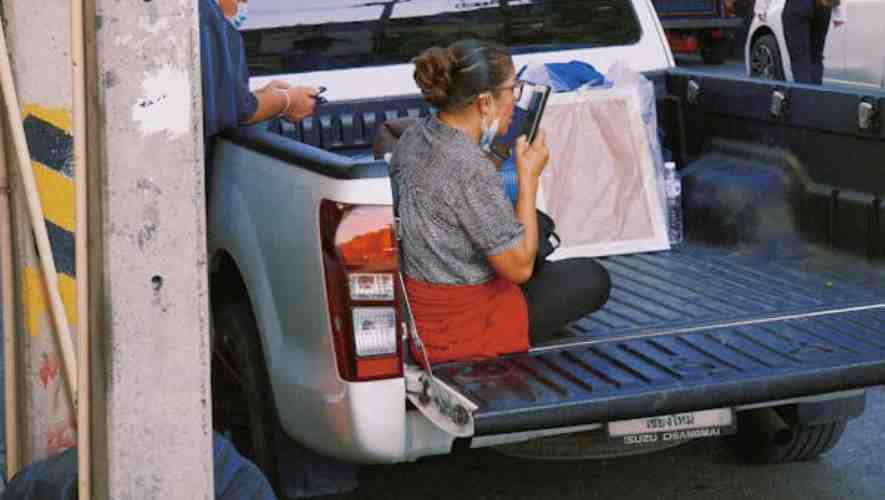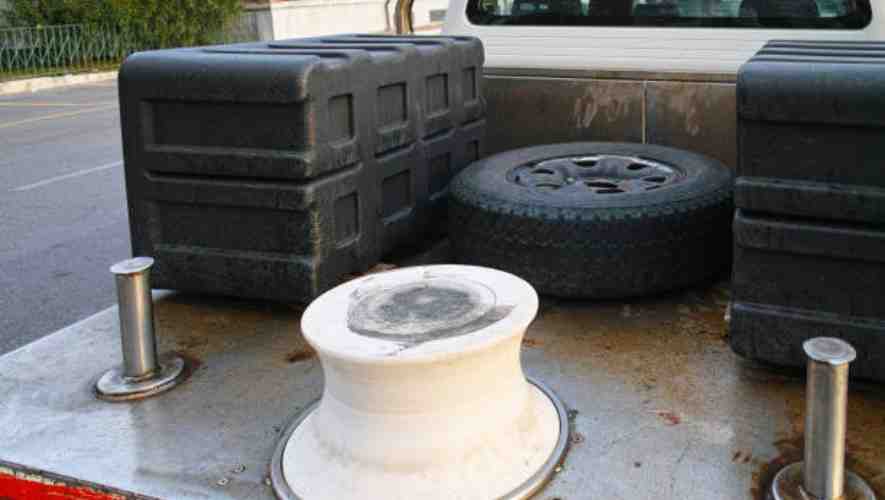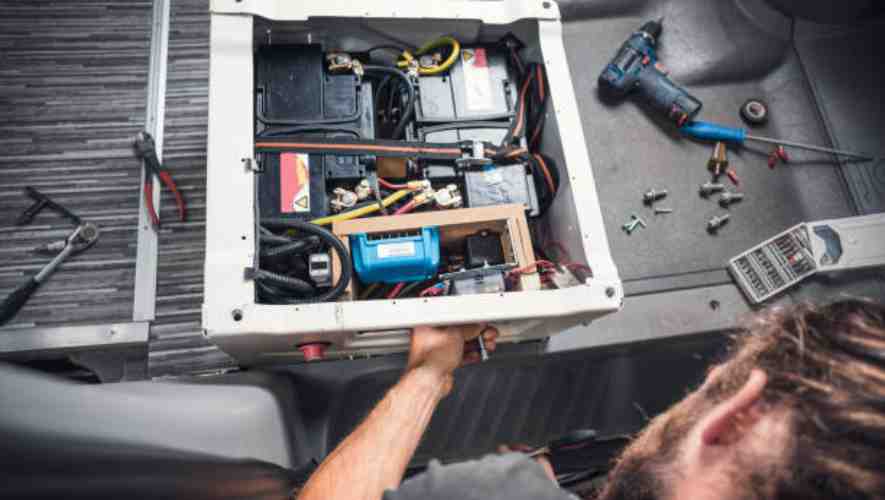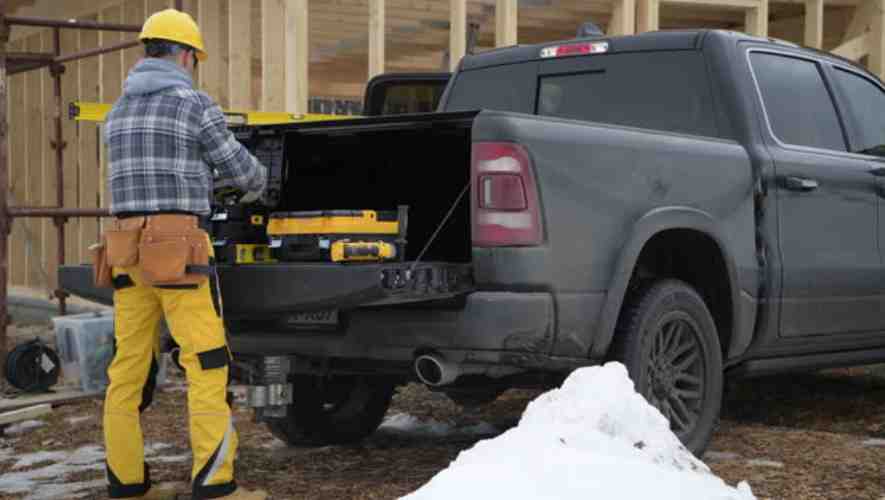When it comes to organizing and protecting your valuable tools, securing a tool chest to your truck bed is essential.. The thought of drilling holes into your truck may make you hesitate, fearing potential damage or the voiding of warranties. This is a common concern among truck owners who value the integrity and aesthetics of their vehicle but need a practical solution for tool storage during transit.
How To Secure Tool Chest To Truck Bed Without Drilling? Securing a tool chest to your truck bed without drilling is possible by using a no-drill toolbox mount, utilizing tie-downs or employing a truck bed rack system. These methods provide stability and security for your tools while preserving the condition of your truck bed.
The guide ahead will navigate through various non-invasive methods to securely attach a tool chest to your truck bed. We’ll explore options like no-drill toolbox mounts, tie-down strategies, and bed rack systems. This information aims to equip you with practical solutions, ensuring your tools are safely transported without compromising your truck’s condition. Get ready to discover how you can protect both your tools and your vehicle effort
Non-Drilling Mounting Options

Tie-Down Straps: Types, Strengths, and How to Use Them Effectively
Tie-down straps are a versatile and reliable solution for securing items without the need for drilling. These straps come in various types, including ratchet straps, cam buckle straps, and loop straps, each suitable for different applications.
The strength of tie-down straps is measured in tensile strength and load capacity, crucial factors to consider based on the weight and nature of the items being secured. Effective use of tie-down straps involves selecting the right type of strap, ensuring it is properly threaded and tightened, and regularly checking for wear and tear.
Friction Mats: Understanding Their Use and Effectiveness
Friction mats offer a straightforward and efficient way to secure items, particularly on flat surfaces. These mats are made from high-friction materials like rubber or textured synthetics, providing a non-slip surface that prevents movement.
Their effectiveness lies in their simplicity; they require no complex installation and can be easily repositioned or removed. Friction mats are particularly useful in protecting surfaces from scratches and reducing the likelihood of items sliding during transport or in high-vibration environments.
Clamp Systems: Different Designs and Installation Techniques
Clamp systems provide a robust non-drilling mounting option, particularly for heavier items. These systems vary in design, from C-clamps to G-clamps and bar clamps, each suited for specific scenarios.
The key to effective clamp system installation is selecting the right design for the load and surface involved. This involves considering the clamp’s opening capacity, throat depth, and clamping force. Proper installation ensures a secure hold without damaging the surface or the item being clamped.
Custom-Made Brackets and Supports That Use Existing Tie-Down Points
For specialized applications, custom-made brackets and supports that utilize existing tie-down points offer an ideal solution. These tailored options are designed to fit specific items and surfaces, providing a secure and bespoke mounting solution.
They leverage existing tie-down points, such as eyelets or hooks, eliminating the need for additional drilling or complex installations. This approach is particularly beneficial for unique or irregularly shaped items, ensuring a snug and secure fit tailored to the specific requirements of the item and the mounting surface.
Safety and Security Considerations

Analyzing the Stability and Security of Non-Drilling Methods
In the realm of modern installations, non-drilling methods for attaching tool chests and other equipment have gained prominence due to their non-invasive nature and ease of modification.
It’s imperative to meticulously analyze the stability and security these methods offer. Factors like the load-bearing capacity, resistance to vibration, and the integrity of the locking mechanism under different conditions must be thoroughly evaluated.
This ensures that the non-drilling method provides a steadfast solution, minimizing the risk of equipment detachment or compromise during transit.
Preventing Theft: Additional Locks and Security Measures
The threat of theft is a perennial concern in the storage and transportation of valuable tools and equipment. To fortify security, integrating additional locks and robust security measures is crucial.
This can involve installing high-quality, tamper-resistant locks, employing advanced locking mechanisms like biometric or electronic locks, and ensuring that the tool chest is constructed from sturdy, impenetrable materials.
Regular audits and maintenance of these security measures are also essential to address any potential vulnerabilities and ensure that the protection offered is uncompromised.
Tips for Ensuring Safe Driving with a Secured Tool Chest
Driving with a secured tool chest necessitates considerations beyond just theft prevention. Ensuring the safety of the driver, passengers, and other road users is paramount. Firstly, it’s important to verify that the tool chest is properly secured and does not obstruct the driver’s view or vehicle controls.
Regular checks to confirm that the chest and its contents remain stable and do not shift during transit are vital.. Understanding the weight distribution and how it affects vehicle handling can help prevent accidents. Finally, ensuring that emergency access to tools is unimpeded can be crucial in unforeseen situations.
Installation Procedures and Best Practices

Step-by-Step Guide for Each Non-Drilling Method
When installing fixtures without drilling, it’s crucial to follow a detailed step-by-step guide for each method. For adhesive methods, start by cleaning the surface thoroughly to ensure strong adhesion.
For suction-based installations, ensure the surface is smooth and non-porous. For tension-based systems, like tension rods, measure the area accurately and adjust the rod accordingly. Each method requires patience and precision to avoid damage and ensure a secure fit.
Tools and Accessories Needed for Installation
The right tools and accessories are essential for a successful non-drilling installation. This includes quality adhesives, strong suction cups, or reliable tension mechanisms, depending on the chosen method.
A level tool is indispensable for ensuring straight and precise alignment. Measuring tapes are necessary for accurate sizing, and cleaning supplies are vital for preparing surfaces. Having these tools at hand streamlines the installation process and enhances the end result.
Tips for Achieving Optimal Stability and Security
Achieving optimal stability and security in non-drilling installations involves several key practices. Firstly, always adhere to the weight limits specified for the chosen method to prevent overloading.
For adhesive applications, allowing sufficient curing time is crucial for strength. In suction and tension installations, regular checks and adjustments ensure ongoing stability. Using high-quality materials specifically designed for non-drilling installations can significantly enhance security and durability.
Maintenance and Inspection Routines for Prolonged Safety
Regular maintenance and inspection are paramount for prolonged safety in non-drilling installations. This involves periodic checks for any signs of wear, loosening, or degradation. For adhesive methods, inspect the bond strength and reapply if necessary.
Suction cups should be cleaned and reattached to maintain suction strength. Tension systems require regular adjustment to ensure they remain tight and secure. A proactive approach to maintenance and inspection can prevent accidents and extend the lifespan of the installation.
Case Studies and Real-World Applications

Examples of Successful Installations Using Non-Drilling Methods
Successful installations using non-drilling methods are increasingly common, reflecting their growing popularity among truck owners. One notable example is the use of magnetic and suction-based systems for mounting equipment on service trucks.
These methods allow for easy installation and removal without compromising the truck’s exterior. Another example is the use of clamp-on racks and carriers, which have been effectively utilized in various industries, from construction to logistics. These examples not only demonstrate the feasibility of non-drilling methods but also their versatility across different sectors.
Interviews or Testimonials from Truck Owners or Professionals
The insights from truck owners and professionals who have adopted non-drilling methods are invaluable. Interviews and testimonials often reveal the practical advantages of these solutions, such as the ease of installation and the absence of permanent alterations to the vehicle. Many truck owners appreciate the preservation of their vehicle’s resale value, a significant benefit of non-drilling methods. Professionals in the field also note the time saved in installation and the enhanced flexibility in modifying and customizing their vehicles to meet specific needs.
Analysis of Different Scenarios and the Best Fitting Non-Drilling Solution
Analyzing various scenarios where non-drilling methods are applicable is crucial in understanding their range of effectiveness. For instance, in temporary vehicle assignments, non-drilling solutions are ideal due to their reversibility.
Similarly, for leased vehicles, where permanent modifications are often prohibited, non-drilling methods offer a viable alternative. The best fitting solution depends on factors like the type of equipment being installed, the duration of its necessity, and the specific requirements of the truck’s usage. This analysis helps in making informed decisions that align with the unique needs of each situation.
Conclusion
Securing your tool chest to the truck bed without drilling is not only possible but also practical and effective. Opting for alternatives like no-drill mounts, tie-downs, or truck bed rack systems ensures your tools are secure while keeping your truck bed intact.
In conclusion, whether you’re a professional tradesperson or a DIY enthusiast, it’s clear that you don’t have to compromise the integrity of your truck bed to keep your tools secure. Exploring these no-drill options offers a blend of security and preservation, ensuring peace of mind while you’re on the move. It’s a win-win situation, providing the perfect balance between protecting your investment in your tools and maintaining the pristine condition of your truck. So, go ahead and make an informed choice, knowing that your tools and truck bed can remain in top-notch condition, no drilling required!

